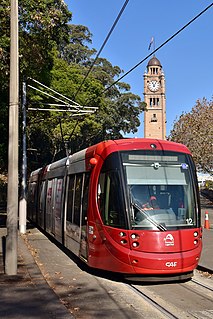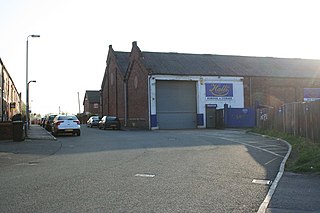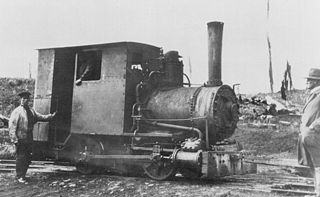
Launceston is a city in the north of Tasmania, Australia, at the junction of the North Esk and South Esk rivers where they become the Tamar River (kanamaluka). With a population of 87,328, Launceston is the second most populous city in Tasmania after the state capital, Hobart, and the twelfth-largest non-capital city in Australia.
The Paddington tram depot in Brisbane, Australia was destroyed by fire on the night of 28 September 1962, one of the largest fires in Brisbane's history. Sixty-five of Brisbane's trams were destroyed. The destruction of the depot is generally seen as the beginning of the end for Brisbane's tram system, providing the justification for the subsequent closure of four tram routes and the gradual encroachment of bus operation on other tram routes, with the final closure of the tram system occurring on 13 April 1969.

The Melbourne & Metropolitan Tramways Board (MMTB) was a government-owned authority that was responsible for the tram network in Melbourne, Australia between 1919 and 1983, when it was merged into the Metropolitan Transit Authority. It had been formed by the merger of a number of smaller tramway trusts and companies that operated throughout the city.

The Brisbane tramway network served the city of Brisbane, Australia, between 1885 and 1969. It ran on standard gauge track. The electric system was originally energised to 500 volts, and subsequently increased to 600 volts. All tramcars built in Brisbane up to 1938 had an open design. This proved so popular, especially on hot summer nights, that the trams were used as fundraisers and often chartered right up until the last service by social groups.

Metro Tasmania, commonly called Metro, a Tasmanian Government business enterprise, is the largest bus operator in the state of Tasmania, Australia, with operations in three of the four largest urban centres of Hobart, Launceston, and Burnie. Urban services in Devonport are provided by a private operator, Merseylink Coaches, although Metro does operate a route via Devonport which links the Mersey Community Hospital in Latrobe with the North-West Regional Hospital in Burnie. Services are provided by Metro under a range of urban and non-urban contracts with the Transport Commission, a division within the Department of State Growth.

Launceston City Council is a local government body in Tasmania, located in the city and surrounds of Launceston in the north of the state. The Launceston local government area is classified as urban and has a population of 67,449, which also encompasses the localities including Lilydale, Targa and through to Swan Bay on the eastern side of the Tamar River.

Mowbray is a suburb of Launceston in the Australian state of Tasmania and is the site of Mowbray Racecourse, home of the Launceston Cup. Mowbray also contains the minor suburbs of Mowbray Heights and Vermont. The suburb of Mowbray is located on a flat-topped, alluvial shelf, known as Mowbray Hill, roughly 28m above the Tamar River and its flood plains.

The earliest trams in Australia operated in the latter decades of the 19th century, hauled by horses or "steam tram motors". At the turn of the 20th century, propulsion almost universally turned to electrification, although cable trams lingered in Melbourne. In cities and towns that had trams, they were a major part of public transport assets.

Glasgow Corporation Tramways were formerly one of the largest urban tramway systems in Europe. Over 1000 municipally-owned trams served the city of Glasgow, Scotland with over 100 route miles by 1922. The system closed in 1962 and was the last city tramway in Great Britain.

Dundee Corporation Tramways formerly served the City of Dundee in Scotland. The Corporation had financed the construction of a horse tramway in 1877, but had then leased it to the Dundee and District Tramways Company. They had replaced most of the horse trams with steam tram locomotives pulling trailer cars from 1884, but in 1897 the Corporation decided that it would run the tramway system itself. After some negotiation and the payment of compensation, they took over the system in 1899, with a view to electrifying it. Electric trams started running in 1900, and the changeover was completed in 1902.

The Australian city of Hobart, Tasmania's capital city, no longer has a network of trams operating, but it once had an extensive and popular system that reached the majority of Hobart suburbs. The Hobart tram network was established in 1893 by a private consortium known as the Hobart Electric Tram Company, providing Hobart with the first complete electric tramway in the Southern Hemisphere. Its fleet of double-decker trams were the only such trams in Australia.

The Fremantle tramway network linked the central business district of Fremantle, the port city for Perth, Western Australia, with nearby suburbs. Small but comprehensive, it operated between 1905 and 1952.

The Hobart trolleybus system was part of the public transport network in Hobart, the capital city of Tasmania, Australia, for more than 30 years in the mid-twentieth century.
The Launceston trolleybus system was part of the public transport network in Launceston, Tasmania, Australia, for nearly 20 years in the mid-20th century.

Wigan Corporation Tramways operated a tramway service in Wigan, England, between 1901 and 1931. The first tramway service in the town was run by the Wigan Tramways Company, whose horse trams began carrying passengers in 1880. They began replacing horses with steam tram locomotives from 1882, but the company failed in 1890, when a Receiver was appointed to manage it. The Wigan & District Tramways Company took over the system in 1893, and ran it until 1902. Meanwhile, Wigan Corporation were planning their own tramway system, obtaining an authorising Act of Parliament in 1893, and a second one in 1898. This enabled them to build electric tramways, and in 1902, they took over the lines of the Wigan & District Tramways Company.

The city of Geelong in Victoria, Australia, operated an extensive tramway system from 1912 until 1956, when the service was replaced by buses. Unlike Victoria's other major regional cities, Ballarat and Bendigo, which have kept some track and trams as tourist attractions, no trams or tracks remain in Geelong.

The N-class trams were a crossbench design of tram with a two-bogie design, each pair of benches had doors at each side.

Grubb's Tramway was a partially completed, private logging tram line in Tasmania from the junction of the Launceston-George Town Road at the Tamar River near Mowbray to a saw mill at Pipers River.

The Marrawah Tramway was a 28 miles (45.1 km) long narrow gauge forest railway near Marrawah in Tasmania with a gauge of 3 ft 6 in. The construction was initiated around 1911 to harvest timber in the Mowbray Swamp. The tramway was bought by the state government in October 1913 and the steel rails extended to Marrawah. It was decommissioned in 1961.
The Melbourne tram network began in 1884 with the construction of the Fairfield Horse Tramway. However, the purpose of the line was to increase land prices in the area, and it soon closed during the depression in 1890. The first genuine attempt to construct a tramway network was the construction of the Richmond cable tram line by the Melbourne Tramway & Omnibus Company in 1885. Over the next few years, 16 more cable tram lines were constructed, as well as numerous other horse tramways. The depression of the early 1890s slowed further expansion of the cable network. The first electric tram line was the Box Hill and Doncaster tramway which opened in 1889. This was a pioneering line in what was then the countryside and thus didn't receive much patronage. It closed in 1896. The next attempt at an electric tramway was Victorian Railways' St Kilda to Brighton line, which opened in 1906. Later that year, the North Melbourne Electric Tramway and Lighting Company opened lines to Essendon and Maribyrnong. Many local councils formed their own tramway trusts and built tramways within their own constituency. The most successful of these was the Prahran and Malvern Tramway Trust.

















